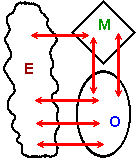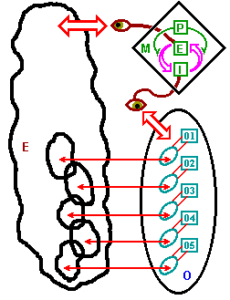The VSM Quick Guide: the model
The introduction to the series on Jon Walker’s VSM quick guide. It describes the simplified VSM vocabulary as used in the rest of the steps.
Brief introduction to the model

The viable systems model considers an organization in its interaction with its environment.
The organization is considered in two parts: The operation that does all the basic work (production, delivery, making money), and the parts that provide a service to the operation by making the whole organization work together in an integrated way (scheduling, accounting, strategic planning…) These parts are called the metasystem.
The following diagram illustrates the basic VSM.
- E stands for the environment
- O stands for the operation
- M stands for metasystem
The arrows show the many and varied ways the three parts work together. Each arrow can have several aspects – it can be information, or trucks, a phone call or a delivery of steel blocks.
The operation consists of a number of operational units. These can be production units or teams of people performing various tasks.
The metasystem can be divided into three main functions:
- The Inner Eye – it looks at the entire collection of operating entities and addresses how to get them to work together in mutually beneficial ways and how to resolve conflicts. This is the “inside and now”.
- The external eye – looking at the external environment, assessing threats and opportunities, and creating plans to ensure the organization can adapt to a changing environment. This is the “outside and then”.
- Policy systems – they set the ground rules that set the tone for the entire organization. The policy rounds out the system. Political systems must have ultimate control.
This is the basic model: the VSM sees any viable system as a collection of operational elements held together by a metasystem.
Both the operation and the metasystem must be in contact and interact with their environment.
The operational units themselves must be viable and can therefore be viewed as smaller viable systems embedded in the larger system.
The model – slightly expanded

Note the three main parts – operation, environment and metasystem.
The metasystem is shown with its internal and external eyes.
The farm is represented as a set of operational units, all of which are smaller embedded viable systems.